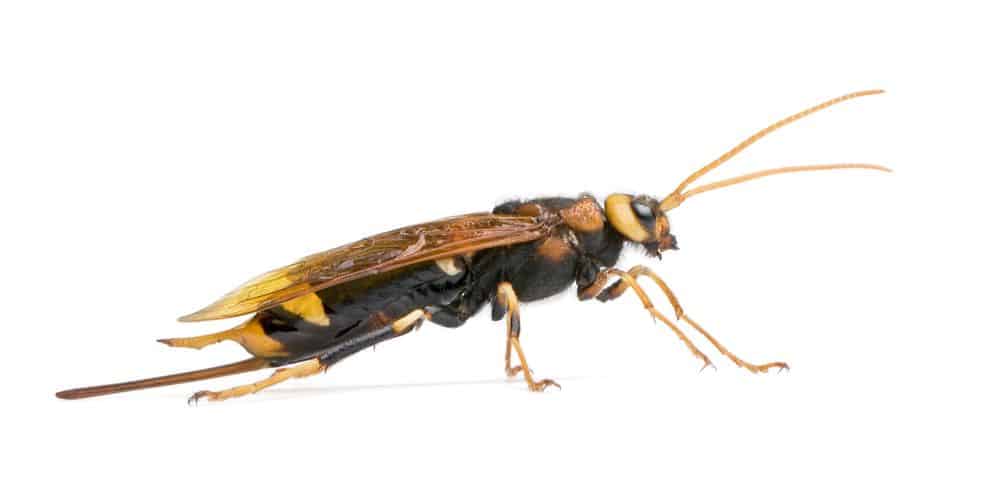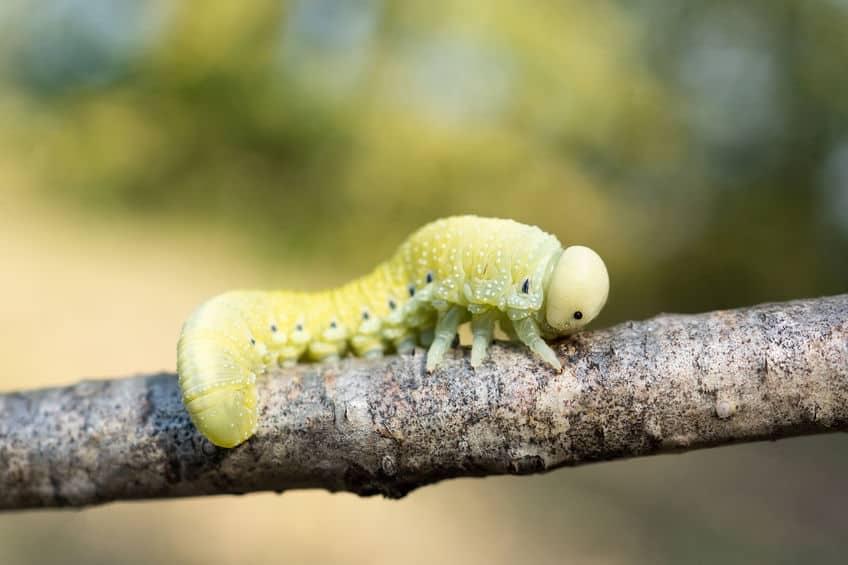What is a Sawfly?
Sawflies are part of the Hymenoptera order of insects alongside wasps, bees, and ants but have their own sub-order known as the Symphyta. Sawflies can often resemble wasps with some species such as the giant woodwasp having a misleading common name. They range in size with the giant woodwasp, also known as horntails, measuring 1.5 inches (4 cm) in length. The term “sawfly” comes from the ovipositor of the females, which resembles a saw and is used for drilling into bark and wood to deposit eggs. Unlike wasps, they do not have a constricted waist can not sting. Sawfly larvae are caterpillar-like, which is a marked difference from the grub-like larvae of wasps and bees. The 100 species of horntail sawflies have a horned spine above the ovipositor.

Where are sawflies found?
Sawflies are found in nearly every place in the world. There are over 7’000 known species of sawfly that are very widely distributed. They are visibly present in the northern hemisphere – most notably the United States and Canada.
Do sawflies sting or bite?
Sawflies do not sting and do not bite people. Females can have a large ovipositor that can resemble a large stinger but is actually only used for depositing eggs. It is used to drill into host plants in order to lay eggs inside.
What do sawflies eat?
Their diet is mainly plant-based. The insects feed on honeydew, sap, pollen, and occasionally other insects. They can pose a nuisance because of their varied appetites for plants. As larvae, they take the form of caterpillars and consume significant quantities of plant matter. In large clusters, they can eat enough to cause significant damage to forests.

Do sawflies pollinate?
Many species of sawflies are considered to be significant pollinators of crops and plants. Their widespread distribution and numbers allow for pollination. Sawflies are often regarded as more of a concern than a help, however, as they are parasitoids of plants. They lay their eggs in host plants that can result in an abnormal outgrowth in the plant’s tissue known as galls.
Where do sawflies nest?
Sawflies will change their habitats at various points of their development as a result of their natural environment. The female insects will drill into plant stems, and tree bark to lay their eggs. When they hatch and reach their larvae form, their weight will force them to drop into the soil below – where they will pupate.
Some of the larvae found in particular sawfly species have further adaptations to their environment. They will cluster in numbers creating an identifiable nest and can emanate irritating resins should they feel threatened by other creatures. In general, sawfly nests are considered damaging to plants.
Do sawflies hibernate?
Sawflies do not hibernate as adults. The insects only live about 7-9 days on average, with lifespans varying depending on the species. However, the entire lifecycle of a sawfly takes months or years. As larvae, they will generally stay within the bounds of their habitat, often within a plant or dead tree, through the cold temperatures before pupating. In spring, they will start to emerge, coming into full view in the summertime.
Are sawflies pests?
Sawflies are some of the most prominent pests to forestry as their plant diets are widespread and varied. Caterpillar-like sawfly larvae often feed in groups that cause the destruction of entire plant bases and defoliate their hosts. Well-established plant life is usually not as much at risk to damage from sawfly populations. But smaller, less-endowed ones can be partially or fully defoliated.
As sawfly larvae are not particularly active – they do not feed on more than one plant other than their host. For example, a species known as the dogwood sawfly will only be limited to consuming dogwood. They are containable in that manner. But that’s not to say that they can’t cause considerable destruction to the trees in the immediate area. Cephus and Trachelus sawflies are pests of cereal crops such as wheat, oats, barley, and rye.
Do sawflies have predators?
Like almost all other insects, sawflies do have a healthy predator base keeping their populations in check. Birds, other insects, and small mammals are the main predators of the creatures. Lizards, frogs, shrews, and deer are also known to feed on sawfly larvae while pupating. They are defenseless as many species do not have any deterrents or repellents – but considering their numbers, they are at no risk of decline.
While they are not eaten – humans also are a pseudo-predator to sawflies. They are a threat to crops and therefore are removed where possible. Farmers and gardeners will often lay chemicals that kill them when discovered – or place forms of repellent to keep them away.
